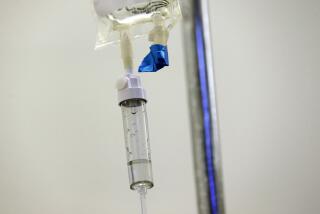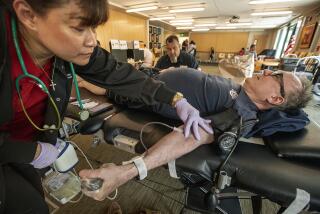These Banks Want to Be in the Red
- Share via
Imagine that your daughter is about to have her tonsils removed. Everything’s arranged, right down to your family leave and her school makeup tests, but then the hospital calls and says all elective surgery is being postponed because there isn’t enough blood if an emergency transfusion is needed.
Fiction? Or prediction?
Regional and seasonal blood shortages that curtail elective surgery could become more frequent as soon as 2000, according to projections from the National Blood Data Resource Center. The center found that 8% of hospitals nationwide reported some spot shortages that resulted in canceled or postponed elective surgery over the course of a single year.
If past trends continue, the center estimates 11.7 million units will be donated next year when hospitals will need 11.9 million.
The shortfall that the data resource center released in February got the federal government moving and shifted some attention away from safeguarding the blood supply from disease to finding ways to boost reserves.
“We’ve gotten an early warning sign and . . . we’re acting on it,” said Dr. Stephen D. Nightingale, executive secretary of the Department of Health and Human Services’ Advisory Committee on Blood Safety and Availability. The committee includes representatives from consumer groups, physicians, nonprofit blood centers, the plasma industry and patients who suffer from such blood diseases as sickle cell anemia and hemophilia. “Even if one person has surgery postponed by a day, that’s of concern to us.”
His boss, Surgeon General David Satcher, also commissioned a special panel of the U.S. Public Health Service, an agency he also heads, to explore ways to expand supplies.
The two panels recognized a need for current data. As a result, the National Heart, Lung and Blood Institute, part of the National Institutes of Health, has committed $300,000 to begin monthly monitoring of the national blood supply.
Concerns were further heightened Aug. 17 when the Food and Drug Administration told the industry to stop collecting blood from anyone who spent a cumulative six months or more in Great Britain between 1980 and 1996, the time of the “mad cow disease” epidemic. Although there’s no evidence anyone in the U.S. is at risk for a human form of the brain illness, no one wants to take chances with blood transfusions.
Banning donations by such visitors or short-term residents of Britain will cut 2.2%--or about 264,000 of the 12 million units drawn annually from 8 million Americans, the American Red Cross calculates.
Already, federal agencies are moving to fill that gap. They’re allowing donations from people with a genetic disease called hemochromatosis, which involves an excess of red blood cells. That could add up to 300,000 units annually. People with the disorder regularly have blood drawn to reduce the excess red blood cells, a procedure they pay for. The blood drawn from them is perfectly good, but it’s discarded. The worry among blood center officials is that those people would have a financial incentive to donate their blood and save the medical fees. Blood centers can now obtain federal waivers to salvage that blood.
The Advisory Committee on Blood Safety and Availability seeks strategies that encourage regular donors to give more frequently than their average 1.5 times a year. If blood banks could increase from 35% to 50% the number of individuals who give a second unit annually, that would augment the national supply by 10%, Nightingale says.
*
Appeals for donations are nothing new--each summer and winter, blood agencies appeal for donors, especially those of certain blood types.
If you drive by the National Institutes of Health in Bethesda, Md., any time of the year, you’ll see an outdoor reminder of the need for O negative blood, says Nightingale, who drives past the sign daily.
At the USC Blood Donor Center in Los Angeles, which serves three USC hospitals, supplies are slim now, says nursing supervisor George Martinez.
“During the summertime, there’s a lot of people who don’t donate. They’re on vacation. It’s too hot for some people to make it [to the center],” Martinez says. “There’s also an increase in people getting hurt. The need is tremendous.”
Blood donations typically bounce back in the fall, when high school students who are at least 17 and college students respond to campus blood drives. In winter, when holiday accidents rise and flu season keeps some donors in bed, supplies again wane.
But the shortage foreseen in 2000 has roots in recent trends. The demand for blood has grown with increased organ transplants and more aggressive chemotherapy for cancer patients, while donations have leveled off or decreased.
Although proposed studies will examine donor psychology, Marian Sullivan, executive director of the National Blood Data Resource Center in Bethesda, Md., says there’s speculation “that the post-World War II generation had a whole different kind of feeling of community spirit and altruism . . . than today’s generation.”
Sullivan, whose projections earlier this year were based on 1997 figures, the most recent available, is conducting a quick survey of all U.S. blood centers this month to see if the projection is “on track” and will present findings in November to the American Assn. of Blood Banks.
The current summer shortage started in May, “a little earlier than you would expect,” and Sullivan said experts “really can’t distinguish the seasonal shortages from what could be the beginning of a broader, longer-lasting shortage.”
She’s confident the country’s blood supply can weather major disasters because of computer tracking and overnight shipping between regions.
But Dr. Richard J. Davey, chief medical officer for the American Red Cross, noted that after the Oklahoma City bombing in 1995, local hospitals depleted a stockpile of 354 units in just four hours and “planes don’t fly that fast.”
Davey, also a consultant to the federal blood safety committee, says the Red Cross has aggressively pursued new donors, upping collections by 200,000 units last year. He suggests streamlining the donation process, which would include overhauling time-consuming donor questionnaires, and focusing on young recruits to replace older donors who eventually drop out. About 12% of Red Cross donations come from 17- to 20-year-olds.
The Red Cross shies from giveaways, based on evidence that “when the incentive becomes the reason people come to donate, it brings in a group of donors that may be a potentially higher risk group.”
Davey would like public officials and celebrities to lead a public service campaign promoting donation as a civic duty. At the committee’s last meeting, Aug. 26 and 27, Satcher said he and senior health services managers “are willing and, in fact, eager to participate in appropriate industry-sponsored programs to increase blood donation.”
Davey called projected shortfalls, combined with the latest donor “U.K. restrictions,” “kind of a shot across the bow that we’d better be very concerned about the number of units of blood we have in this country.”
More to Read
Sign up for Essential California
The most important California stories and recommendations in your inbox every morning.
You may occasionally receive promotional content from the Los Angeles Times.









